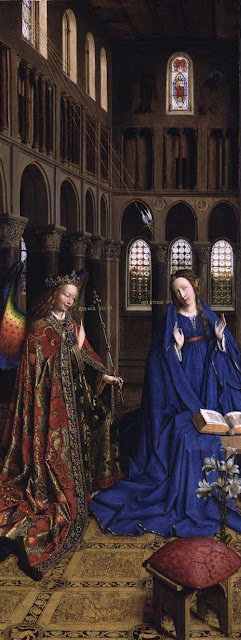THE OFFICIAL
TRINITYPREPART
STUDY GUIDE TO
ART HISTORY TEST #2
The story continues...
Activity of painters in Europe
15th - 17th Centuries
"It is not bright colors
but good drawing that makes figures beautiful."
Tiziano Vecelli
better known as Titian
Assumption of the Virgin
Santa Maria Gloriosa dei Frari
1516-1518
Titian
This quarter's lectures began with the painter known as Titian (ca. 1488-1576). Titian was born in the Republic of Venice. Sixteenth Century Venice was the European center of the pigment trade. As an important sea port, canvas was readily available in Venice for the sails of ships. The combination of valuable pigments (Ultramine, Azurite and Vermilion, to name a few) and rolls of canvas, tethered with experimentation, led Titian to become the premier painter of the Venetian School. His patrons included Phillip II of Spain, Francis I of France, Emperor Charles V of Germany and Pope Paul III. One of Titian's contributions to oil painting is the technique of scumbling- thin layers of light, transparent color over darker, opaque color. Titian is one of the earliest painters to employ scumbling, and is believed by some to be the inventor.
nota bene- Titian attended the 25th Session of the Council of Trent, from which the following was issued:
...every superstition shall be removed ... all lasciviousness be avoided; in such wise that figures shall not be painted or adorned with a beauty exciting to lust... there be nothing seen that is disorderly, or that is unbecomingly or confusedly arranged, nothing that is profane, nothing indecorous, seeing that holiness becometh the house of God.
Supper at Emmaus
1530
Titian
The Holy Family
ca. 1510
Titian
Jan van Eyck, ca. 1395- ca. 1441, is traditionally known as "the father of oil painting". Jan van Eyck's glazing techniques (transparent layers of color) and attention to detail represent the zenith of 15th Century Flemish painting.
The Arnolfini Portrait
1434
Jan van Eyck
Detail from The Arnolfini Portrait
The Ghent Altarpiece
1432
Jan van Eyck
Detail from The Ghent Altarpiece
Annunciation
ca. 1436
Jan van Eyck
Detail from Annunciation
Albrecht Durer, 1471-1528, is considered one of the greatest artists of the Northern Renaissance. Born in Nuremberg, Germany, Durer excelled in painting, printmaking, drafting and typography. Durer produced more than 350 engravings and woodcuts and over 60 paintings in oil and watercolor; among the most celebrated are his self-portraits.
Self-Portrait
1500
Albrecht Durer
The Large Turf
Watercolor
1503
Albrecht Durer
Four Horsemen of the Apocalypse
Woodcut
1498
Albrecht Durer
Caravaggio, 1571-1610, revolutionized Italian Mannerist painting with the technique known as tenebrism- a style which incorporates extreme lights and darks with greater emphasis on the darks, a style which would come to be known as Caravaggism. Caravaggio's lifestyle was as dramatic as his art; in a six-year period he was brought to trial at least eleven times. His charges include:
beating a fellow painter
wounding a soldier
throwing a plate of artichokes into the face of a waiter
throwing stones at the Roman Guard
and
killing Ranuccio Tomassoni
(over a score dispute in a tennis match).
The Calling of Saint Matthew
1600
Caravaggio
The Conversion of Saint Paul
1601
Caravaggio
Supper at Emmaus
1601
Caravaggio
A comparison in style- Supper at Emmaus
Rembrandt Harmenszoon van Rijn, 1606-1669, was born 25 miles south of Amsterdam. He is considered to be the greatest Dutch artist and one of the greatest artists in European history. His legacy of work includes some 300 paintings, 1400 drawings and 300 etchings. Rembrandt's favorite subject matter included portraits (he painted more than 90 self-portraits) and Biblical scenes.
Self-Portrait
Etching
1630
Rembrandt
Belshassar's Feast
1638
Rembrandt
The Hundred Guilder Print
Etching
1649
Rembrandt
Holy Family
1645
Rembrandt
A comparison in style of the Madonna and Child
The Return of the Prodigal Son
1669
Rembrandt
Johannes Vermeer, 1632-1675, was born in Delft, a Dutch town famous for Delftware, tapestry weavers and breweries. Little is known of Vermeer's personal life. Only 36 paintings are attributed to his hand and yet his relatively 'small' body of work speaks with a grandeur that is rarely seen today. His methodology involved four steps:
1. Inventing (The drawing)
2. Dead coloring (The underpainting or 'blocking in')3. Working up (Adding color and detail)
4. Retouching (Layers of glazing)
Christ in the House of Martha and Mary
1654-1655
Vermeer
The Little Street
1661
Vermeer
Girl With a Pearl Earring
1667
Vermeer
The Art of Painting
1668
Vermeer



























a beautiful collection of work here. and at hi/decent rezzzzzz :)
ReplyDelete